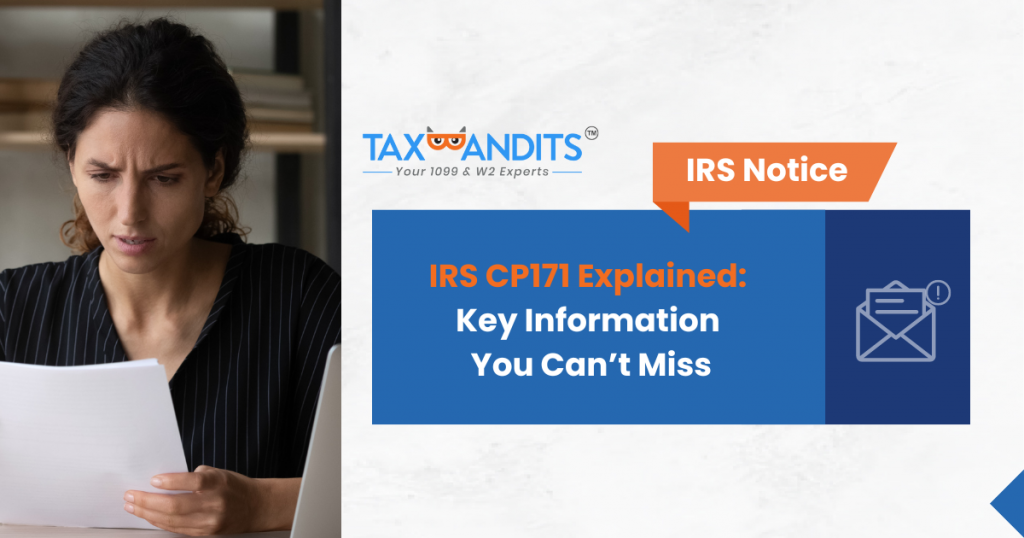IRS CP171 Explained: Key Information You Can’t Miss
reading time: 13 minute(s)

Receiving a tax notice or letter can be a challenging experience. It can be confusing and frustrating if you need help understanding why you received the notice in the first place. One such notice that can cause concern is IRS Notice CP171. The IRS uses Notice CP171 to remind businesses of taxes owed. This detailed guide will help you understand what IRS Notice CP171 is, why you might receive it, and the steps you should take if you do.
In one of our previous articles, we explained the IRS Letter 226-J. In this article, we will explain the IRS CP171 notice.
Let’s get started with the basics.
What is IRS Notice CP171?
IRS Notice CP171 is an annual reminder sent by the IRS to taxpayers regarding the amount of tax owed( balance due) on their tax account, along with interest and penalty. This notice is a last reminder before the IRS takes further collection actions. It’s critical communication, signaling that your tax debt needs immediate attention to avoid escalating issues such as additional penalties and interest, which must be corrected immediately.
Essential Details Found in IRS CP171 Notice
The CP171 notice includes critical information that you need to review carefully:
- Tax Year: Specifies the tax year for which the balance is owed.
- Amount Due: The outstanding tax balance and any penalties and interest accrued.
- Payment Deadline: A due date by which the payment should be made to avoid additional penalties and interest.
- Payment Options: Information on how to make the payment, including online options, payment plans, or installment agreements.
- IRS Contact Information: Details on how to contact the IRS if you have questions or need assistance.
Why Do You Receive the IRS CP171 Notice?
You typically receive IRS CP171 for the following reasons:
- Unpaid Balance: You have an outstanding balance that has yet to be paid by the due date.
- Missed Payment Plan: If you had an installment agreement and missed one or more payments, this notice reminds you of the outstanding debt.
- Penalty and Interest Accumulation: The notice also includes any penalties and interest added to your original balance, which will continue to accrue until the full payment.
What are the Immediate Steps to Follow Upon Receiving IRS CP171?
Receiving IRS CP171 can be stressful, but taking prompt action is crucial. Here are the steps you should follow:
- Review the Notice: Carefully read the notice to understand the amount owed and the deadline. Ensure the details match your tax records.
- Verify the Information: Cross-check the information with your own tax records. If you believe there is an error, contact the IRS immediately using the phone number in the notice.
- Make Payment Arrangements: Pay the total amount by the due date. You can pay online through the IRS website, mail, or through an approved payment processor. If you cannot pay the total amount, explore other options, like setting up a payment plan or requesting an installment agreement.
- Consider Penalty Abatement: If you have a valid reason for missing payments, such as a financial hardship or unforeseen circumstances, you can request penalty abatement. This can reduce or eliminate penalties, though you may still owe the original tax amount and interest.
- Seek Professional Assistance: If the amount due is significant or you are uncertain about the next steps, consider consulting a tax professional. They can help you navigate the process, ensure you understand your obligations, and potentially negotiate with the IRS on your behalf.
How to Prevent Future IRS CP171 Notices?
To avoid receiving similar notices in the future, consider these proactive steps:
- Set Up Automatic Payments: Establish automatic payments or reminders to ensure timely tax payments.
- Review Tax Payments Regularly: Review your tax payments and accounts with the IRS regularly to catch any discrepancies early.
- Communicate with the IRS: If you encounter financial difficulties, communicate with the IRS as soon as possible to explore alternative payment options rather than waiting for notices.
Ensure Compliance and Avoid IRS Penalties with TaxBandits.
Meeting the Affordable Care Act (ACA) reporting requirements can be challenging for businesses, especially when trying to avoid IRS penalties. That’s where TaxBandits can help.
With years of experience in ACA reporting, TaxBandits provides a complete solution for every step of the process. From creating and submitting Form 1095-C and Form 1095-B to the IRS and state agencies to generating the required ACA 1095 codes, TaxBandits makes the whole process easier.
We’re also dedicated to ensuring that ACA forms reach your employees in a simple and secure way, whether through an online portal or by mail. Our team is here to guide you through the e-filing process so you can confidently file Form 1095-C and 1095-B.
Stay connected with us in the coming weeks as we share more important updates in our ACA notice series.


Leave a Comment